What antibiotics are most effective for colds. New generation broad-spectrum antibiotics (list and names)
"Magic Bullets"
The term “antibiotic” comes from two Latin words: anti – against and bios – life. Antibiotics are organic matter, capable of fighting bacteria: preventing their reproduction or completely destroying them. The very first effective antibiotic is considered to be penicillin, discovered in 1929 by the English microbiologist Alexander Fleming. The first antibiotics were called “magic bullets,” designed to radically change the treatment of infectious diseases. Modern medicine has hundreds of antibiotics designed to treat various diseases.
New generation drugs
There is a strong opinion that the most effective, reliable and safe drugs are the “new generation” ones, and in many cases this is true. However, you need to know that most antibiotics act selectively, that is, they are effective against one or two bacteria, in particular as a last resort- several types.

Klabax is a “new generation” antibiotic that has international name clarithromycin, refers to pharmacological group macrolides. This drug not only destroys bacteria, it also improves immunity. Klabaks is one of the best antibiotics against typical and atypical pathogens, as well as against chlamydia. Clarithromycin is concentrated in the plasma, thereby preventing the occurrence of bacteremia.
Sumamed, who has an international generic name Azithromycin is the first representative of a new class of azalide antibiotics. This drug improves the clinical results of treatment, reduces the likelihood of the formation of resistant strains, and reduces the likelihood of a repeat course of antibiotic therapy.
Bactericidal antibiotics
Along with tablets, capsules and suspensions, there are antibiotics local action in the form of nasal sprays. These medications include Isofra, a drug containing the bactericidal antibiotic framycetin. The spray works great with acute rhinitis, nasopharyngitis and sinusitis. Besides this he is an excellent remedy for treatment inflammatory processes after operations.
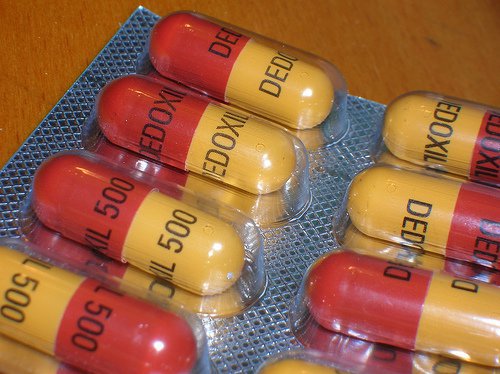
Polydexa drug
Also for the treatment of sinusitis and nasopharyngitis, the drug Polydexa in the form of a nasal spray is intended. Very good result when using this remedy, it is achieved through a combination of the antiallergic and inflammatory effects of dexamethasone and the antibacterial effects of neomycin and polymyxin - two effective complementary antibiotics.
But, as you know, modern science does not stand still, and almost every year new, more effective antibiotics helping people deal with various diseases. Of course, you should not treat antibiotics as a panacea, but in some cases it is simply impossible to completely abandon their use.
Therapy of diseases caused by pathogenic bacterial microflora requires the right choice etiotropic drug. Antibiotics wide range actions of the new generation take into account factors of bacterial resistance and for the most part do not suppress the growth of normal intestinal microflora. However, they cannot be used without a doctor's prescription. These drugs have a detrimental effect on cellular immunity, can create resistance to therapy, and provoke the appearance of negative side effects. The list of broad-spectrum antibiotics in injections and tablets presented here is intended for informational purposes only. All names are taken from pharmacological reference books, mostly these are trademarks. The same drugs may be available in the pharmacy chain in the form of analogues that have the same active ingredient and completely different names.
The material also provides background information on recommended daily and course dosages. A list of bacterial microflora is provided for which treatment with one or another agent can be used. But it’s worth clarifying right away that any treatment must begin with a visit to the doctor and bacterial analysis to clarify the sensitivity of pathogenic microflora to a range of antibiotics.
The content of the article:
An excursion into the microscopic world of bacteria
In order to understand how and what broad-spectrum antibiotics affect, you need to understand the representatives of the bacterial world. An excursion into the microscopic and mysterious world bacteria can be done in any bacterial laboratory. The vast majority of these microorganisms can only be seen under a powerful microscope eyepiece. This is precisely what allows them to dominate the world. Invisible to the eye, they dot with themselves and their colonies absolutely all surfaces, food, household items and human skin. By the way, the epidermis is the first natural barrier to potential enemies - bacteria. When they come into contact with the skin, they encounter a film of sebum that is impenetrable to them. If the skin is dry and prone to cracking, then this protection is significantly reduced. Regular water procedures With detergent increase the chances of not getting infections by almost 5 times.
In its structure, any bacterium is a prokaryote that does not have its own protein core. The first prototypes of this microflora appeared on the planet more than 4 million years ago. Currently, scientists have discovered more than 800,000 species of different bacteria. More than 80% of them are pathogenic for the human body.
The human body contains a huge amount of bacterial microflora. Most of lives in the intestines, where the basis of cellular humoral immunity is formed. In this way, bacteria can be beneficial to humans. If the bacterium is responsible for the condition immune status. Some species help break down food and prepare substances for absorption in small intestine. No lactobacilli human body unable to split milk protein. People with low levels of lacto and bifidobacteria develop serious intestinal disorders, decreased immunity, and dysbacteriosis.
A huge role in protecting the body from negative factors external environment played by so-called opportunistic bacteria. They are unique trainers of the immune system, teaching it to recognize hostile intrusions and respond to them in a timely manner. When the immune system is weakened and after previous stressful situations opportunistic microflora can become aggressive and cause harm to health.
When choosing a new generation of broad-spectrum antibiotics, preference should be given to those names from the list that, according to the manufacturers, do not suppress the growth of beneficial intestinal microflora.
All bacteria are divided into gram-positive and gram-negative species. The primary division was carried out by Hans Gram in 1885 in what is now Denmark. During his research, to improve visual perception, he painted with a special chemical composition different kinds pathogens. Those of them that changed color were classified as gram-positive. Broad-spectrum antibiotics of the new generation act on both forms of pathogenic microflora.
 The gram-positive microflora includes the entire group of cocci (staphylococcus, streptococcus, gonococcus, pneumococcus) - they differ characteristic shape ball with spikes. This also includes corynobacteria, enterococci, listeria and clostridia. This whole gang can cause inflammatory processes in the pelvic cavity, gastrointestinal tract, respiratory organs, nasopharynx and conjunctiva of the eye.
The gram-positive microflora includes the entire group of cocci (staphylococcus, streptococcus, gonococcus, pneumococcus) - they differ characteristic shape ball with spikes. This also includes corynobacteria, enterococci, listeria and clostridia. This whole gang can cause inflammatory processes in the pelvic cavity, gastrointestinal tract, respiratory organs, nasopharynx and conjunctiva of the eye.
The “specialization” of gram-negative bacteria practically eliminates their influence on the mucous membranes of the upper respiratory tract, however they can infect lung tissue. Most often they cause intestinal and genitourinary infections, cystitis, urethritis, cholecystitis, etc. This group includes salmonella, E. coli, legionella, shigella and others.
Accurately determine the pathogen and its sensitivity to antibacterial therapy allows bacterial seeding of collected physiological fluid (vomit, urine, throat and nasal swab, sputum, feces). The analysis is carried out within 3-5 days. In this regard, on the first day, if indicated, broad-spectrum antibiotics are prescribed, then the treatment regimen is adjusted depending on the sensitivity result.
Names of broad-spectrum antibiotics (list)
Universal treatment regimens in modern medicine not provided. Experienced doctor, based on the history and examination of the patient, can only assume the presence of one or another form of bacterial pathogenic microflora. The names of broad-spectrum antibiotics given below often appear in doctors' prescriptions. But I would like to convey everything to patients possible types their use. This list included the most effective drugs of the new generation. They do not affect viruses and fungal flora. Therefore, they should not be taken for candidal tonsillitis and ARVI.
All drugs of similar action are divided into groups depending on the active substance: penicillins, semisynthetic penicillins, tetracyclines, macrofoams, fluoroquinolones, carbapenems, digitrans, aminoglycosides and amphenicols.
The beginning of the story - "Benzylpenicillin"
Antibiotics first entered the arsenal of doctors a little less than a century ago. Then a group of penicillins growing on moldy bread was discovered. The history of successful fight against pathogenic microflora began in the second world war. It was this openness that made it possible to save hundreds of thousands of lives of soldiers wounded at the front. "Benzylpenicillin" is not a broad-spectrum antibiotic; it is prescribed mainly for inflammatory processes of the upper respiratory tract as a first-choice drug until the sensitivity of the microflora is clarified.
Based on this remedy, more effective drugs were subsequently developed. They have been widely used in patients since early age. This is Ampicillin, which has a broad spectrum of action against gram-positive and gram-negative bacteria.  It can be prescribed when intestinal infections caused by salmonella and E. coli. It is also used to treat bronchitis and tracheitis, which are formed under the influence of coccal flora (streptococcus, staphylococcus). In children, Ampicillin in injections and tablets is prescribed as an effective remedy against Bordetella pertussis, which causes whooping cough. This drug has a long history of use; it was first produced in the late 60s of the last century. It differs in that it does not cause persistence and resistance in most known pathogenic bacteria. Among the shortcomings, doctors call low level availability of the active substance when consumed in tablets. Also, the drug is quickly excreted in urine and feces, which requires increasing the frequency of taking a single dose, sometimes up to 6 times a day.
It can be prescribed when intestinal infections caused by salmonella and E. coli. It is also used to treat bronchitis and tracheitis, which are formed under the influence of coccal flora (streptococcus, staphylococcus). In children, Ampicillin in injections and tablets is prescribed as an effective remedy against Bordetella pertussis, which causes whooping cough. This drug has a long history of use; it was first produced in the late 60s of the last century. It differs in that it does not cause persistence and resistance in most known pathogenic bacteria. Among the shortcomings, doctors call low level availability of the active substance when consumed in tablets. Also, the drug is quickly excreted in urine and feces, which requires increasing the frequency of taking a single dose, sometimes up to 6 times a day.
The standard dosage for an adult is 500 mg 4 times a day for 7 days. For children aged 2 to 7 years, a single dosage of 250 mg. It is possible to administer an intramuscular solution with the addition of Novocaine or Lidocaine. At least 4 injections are required per day.
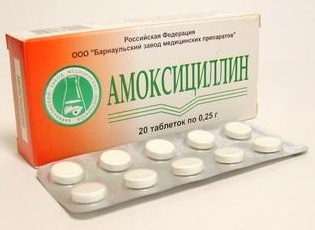 Amoxicillin is more new antibiotic wide spectrum of action. Prescribed for inflammatory processes paranasal sinuses nose, upper respiratory tract, pneumonia, intestinal infections, diseases of the urinary system. Active against a wide range of pathogenic microorganisms. It has been used in medical practice since the late 70s of the last century. Can be used in children with infancy. For these purposes it is available in the form of a suspension.
Amoxicillin is more new antibiotic wide spectrum of action. Prescribed for inflammatory processes paranasal sinuses nose, upper respiratory tract, pneumonia, intestinal infections, diseases of the urinary system. Active against a wide range of pathogenic microorganisms. It has been used in medical practice since the late 70s of the last century. Can be used in children with infancy. For these purposes it is available in the form of a suspension.
Particularly effective in the treatment of inflammatory processes in the upper respiratory tract. This is due to the fact that the concentration of the active substance in the cells of the mucous membranes of the bronchi, trachea and larynx reaches a maximum within 30 minutes and remains there for 5-6 hours. The bioavailability of Amoxicillin is very high - after 40 minutes from taking the tablet orally, the concentration in tissues is 85%. Quickly helps provide bacterial elimination for all forms of bacterial infections purulent sore throat. It is used in combined eradication schemes for Helicobacter pylori (causative agent peptic ulcer stomach and some forms of gastritis).
The standard dosage is 500 mg 2 times a day for 7-10 days. For children, a suspension is prescribed at a dosage of 250 mg 2 times a day.
 Augmentin and Amoxiclav are two more modern broad-spectrum antibiotics from the penicillin series. They contain clavulanic acid. This substance destroys the shell pathogenic bacteria and accelerates the process of their death. These drugs do not have injection forms. They are used only in tablets and suspension form.
Augmentin and Amoxiclav are two more modern broad-spectrum antibiotics from the penicillin series. They contain clavulanic acid. This substance destroys the shell pathogenic bacteria and accelerates the process of their death. These drugs do not have injection forms. They are used only in tablets and suspension form.
Broad-spectrum antibiotics in injections are prescribed for severe inflammatory processes. They quickly reach the source of inflammation and have a bactericidal effect on microorganisms. Prescribed for abscesses caused by resistant forms, such as Pseudomonas aeruginosa. Sensitivity is detected against streptococci and pneumococci, staphylococci and enterobacteria.
Ampisid is available in both tablets and injections. It contains ampicillin and sulbactam, which inhibits lactamase and eliminates the effect of resistance in all pathogenic microorganisms without exception. Prescribed 2 times a day for intramuscular injection and taking tablets.
"Carbenicillin" is available in the form of disodium salt in bottles with powder, which can be diluted with water for injection, novocaine and lidocaine before injection. Used for persistent forms of inflammatory processes in the chest and abdominal cavity, bronchitis, tonsillitis, paratonsillar abscess. It shows high effectiveness in meningitis, blood poisoning, peritonitis, and sepsis. Intravenous drip administration used in postoperative period. In other cases, it is prescribed intramuscularly at 500 - 750 units 2 times a day.
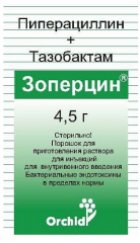 Another effective drug, Piperacillin, is used in anti-inflammatory therapy in combination with the drug Tazobactam. It is this combination that deprives the coccal flora of resistance. It is advisable to conduct a preliminary bacterial culture to determine the sensitivity of microorganisms. If there is no production of penicillinase, then it is possible to prescribe combination therapy only Piperacillin. It is administered intramuscularly for severe tonsillitis, tonsillitis, pneumonia and acute bronchitis.
Another effective drug, Piperacillin, is used in anti-inflammatory therapy in combination with the drug Tazobactam. It is this combination that deprives the coccal flora of resistance. It is advisable to conduct a preliminary bacterial culture to determine the sensitivity of microorganisms. If there is no production of penicillinase, then it is possible to prescribe combination therapy only Piperacillin. It is administered intramuscularly for severe tonsillitis, tonsillitis, pneumonia and acute bronchitis.
Ticarcillin is not highly resistant to penicillinase produced by bacteria. Under the influence of this enzyme, the active substance of the drug will disintegrate without causing any harm to the causative agents of inflammatory processes. Can only be used in cases where the pathogenic microflora does not have resistance to the drug.
 Among the protected forms of broad-spectrum antibiotics from the group of benzylpenicillins, it is worth noting “Trifamox” and “Flemoklav” - these are the latest drugs. No form of infection currently has resistance to their action.
Among the protected forms of broad-spectrum antibiotics from the group of benzylpenicillins, it is worth noting “Trifamox” and “Flemoklav” - these are the latest drugs. No form of infection currently has resistance to their action.
Trifamox is combination drug, which contains amoxicillin and sulbactam, in combination they deal a crushing blow to pathogenic microflora. Prescribed in tablet form and intramuscular injections. Daily dosage for adults is 750 - 1000 mg, divided into 2-3 doses. Initial treatment is practiced with intramuscular injections and subsequent taking of tablets.
Fluoroquinolone effective broad-spectrum antibiotics
Fluoroquinolone drugs are highly effective against a wide range of bacterial pathogenic microflora. They reduce the risk of side effects and do not kill the natural intestinal microflora. These effective broad-spectrum antibiotics are entirely synthetic substances.
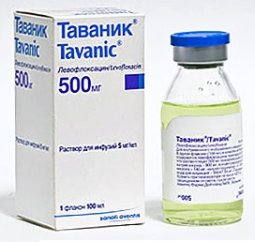 "Tavanic" is a ready-made solution for injection with the active ingredient levofloxacin hemihydrate. Analogues of the drug are Signicef and Levotek. They can be prescribed intravenously and intramuscularly, and there is also a tablet form available in pharmacies. The dosage is calculated strictly individually, depending on the body weight, age of the patient and the severity of the condition.
"Tavanic" is a ready-made solution for injection with the active ingredient levofloxacin hemihydrate. Analogues of the drug are Signicef and Levotek. They can be prescribed intravenously and intramuscularly, and there is also a tablet form available in pharmacies. The dosage is calculated strictly individually, depending on the body weight, age of the patient and the severity of the condition.
In modern medicine, IV generation fluoroquinolones are predominantly used; drugs III generations. The most modern means- this is “Gatifloxacin”, “Levofloxacin”. Outdated forms - "Ofloxacin" and "Norfloxacin" are currently used very rarely due to their low effectiveness. The drugs have toxic activity against the process of peptidoglycan synthesis, which forms connective tissue tendons. Use in patients under 18 years of age is not permitted.
Fluoroquinolones can be successfully used in the treatment of diseases caused by gram-positive and gram-negative bacteria. All forms of pathogenic microflora are sensitive to them, including those capable of producing penicillinase.
 "Levofloxacin" is prescribed for otitis and bronchitis, sinusitis and pneumonia, tracheitis and pharyngitis in tablets. The daily dosage for an adult is 500 mg. Not prescribed for children. The course of treatment is from 7 to 10 days. Intravenous and intramuscular administration may be required for severe course diseases. This is usually done in a specialized hospital under the 24-hour supervision of the attending physician.
"Levofloxacin" is prescribed for otitis and bronchitis, sinusitis and pneumonia, tracheitis and pharyngitis in tablets. The daily dosage for an adult is 500 mg. Not prescribed for children. The course of treatment is from 7 to 10 days. Intravenous and intramuscular administration may be required for severe course diseases. This is usually done in a specialized hospital under the 24-hour supervision of the attending physician.
 Gatifloxacin is an effective drug with low daily dosage and minimal risk of side effects. Daily dose is 200 mg. The course of treatment for diseases of the upper respiratory tract can be reduced to 5 days.
Gatifloxacin is an effective drug with low daily dosage and minimal risk of side effects. Daily dose is 200 mg. The course of treatment for diseases of the upper respiratory tract can be reduced to 5 days.
Avelox and Moxifloxacin are effective for diseases of the ear, nose and throat. Less commonly prescribed for internal infections. Prescribed 1 tablet (400 mg) 1 time per day for 10 days.
"Streptocide" and other aminoglycosides
Among broad-spectrum antibiotics separate group are aminoglycosides. "Streptocide" and other drugs are known to a wide range of patients. They are appointed when various infections. In particular, “Streptotsid” allows you to quickly and effectively treat lacunar and follicular sore throat without the risk of developing intestinal dysbiosis. At the core bactericidal action aminoglycosides is based on the principle of disruption of the protein shell of the bacterial cell, subsequently the synthesis of life-sustaining elements stops and the pathogenic microflora dies.
Currently, 4 generations of this group are produced antibacterial drugs. The oldest of them, “Streptomycin,” is used as injections in combination treatment regimens for tuberculosis. The “Streptotsid” analogue can be injected into the trachea and into tuberculous cavities in the lung tissue. 
"Gentamicin" in modern conditions Mainly used as an external agent. It is not effective when administered intramuscularly. Not available in tablets.
Amikacin is more popular for intramuscular administration. It does not cause the development of deafness, does not have a negative effect on auditory and optic nerve, as is observed with the administration of Gentamicin.
"Tetracycline" and "Levomycetin" - is it worth taking?
Among the well-known drugs, some occupy a worthy and honorable place in any home medicine cabinet. But it is important to understand whether it is worth taking drugs such as Levomycetin and tetracycline. Although there are more modern forms data pharmacological agents, patients prefer to buy them “just in case”.
Broad-spectrum tetracycline antibiotics are produced based on a four-ring structure. They have pronounced resistance to beta-lactamase. Has a detrimental effect on staphylococcal and streptococcal groups, actinomycetes, coli, Klebsiella, Bordetella pertussis, Haemophilus influenzae and many other microorganisms.
 After absorption in the small intestine, tetracyclines bind to blood plasma proteins and are quickly transported to the site of accumulation of pathogenic microflora. Penetrates inside the bacterial cell and paralyzes all vital processes inside it. Absolute ineffectiveness was revealed for diseases formed under the influence of Pseudomonas aeruginosa. It is preferable to prescribe Doxycycline in capsules, 1 capsule 3 times a day. Not prescribed for children under 12 years of age. "Tetracycline" can be used as an effective external agent in the form of ophthalmic and ear drops, ointments for skin and wound surfaces.
After absorption in the small intestine, tetracyclines bind to blood plasma proteins and are quickly transported to the site of accumulation of pathogenic microflora. Penetrates inside the bacterial cell and paralyzes all vital processes inside it. Absolute ineffectiveness was revealed for diseases formed under the influence of Pseudomonas aeruginosa. It is preferable to prescribe Doxycycline in capsules, 1 capsule 3 times a day. Not prescribed for children under 12 years of age. "Tetracycline" can be used as an effective external agent in the form of ophthalmic and ear drops, ointments for skin and wound surfaces.
"Levomycetin" belongs to the group of amphenicols. These are outdated broad-spectrum antibiotics. Used in the treatment of a large number of inflammatory bacterial diseases. The most common use at home is against loose stool caused by food poisoning, salmonellosis and dysentery. And here you should strictly follow the dosage and recommended course of treatment. Prescribed 500 mg 4 times a day. The course of treatment cannot be less than 5 days in a row. Even skipping 1 single dose can create microflora resistance. In this case, it is necessary to immediately change the tactics of antibacterial therapy to avoid negative consequences for good health.
Antibiotics are large group medicinal preparations whose action is aimed at eliminating infectious diseases. Behind Lately new broad-spectrum drugs can be seen. Which drug is the most effective, what is best to take for bronchitis, fever and colds? More about this in more detail.
How antibiotics work
The popularity of antibiotic tablets has increased sharply due to the fact that important processes processes occurring in the cells of the human body differ from similar processes in a bacterial cell. Such strong antibiotics capable of exerting selective actions, affecting only the cells of the pathogenic microorganism, without affecting healthy ones. The classification is carried out based on the way in which the influence on the vital activity of such microorganisms occurs.
When choosing which antibiotic to take, you need to know that some of them suppress the synthesis of bacterial cell membranes, which are absent in the human body. These are broad-spectrum drugs such as penicillins and cephalosporins. Other broad-spectrum drugs can almost completely suppress protein synthesis in bacterial cells. These include tetracycline antibiotics and macrolides. The list of broad-spectrum agents can be divided according to the principle of antifungal activity. It is very important to read the instructions for use of the drugs.
Broad-spectrum drugs are very effective against a number of bacteria, while others may have a narrow focus and are intended for a specific group of bacteria. Why does this happen? The reason is that bacteria and viruses have different functioning and structure, so what can kill bacteria is not effective against viruses. Broad-spectrum agents are used when:
- The causative agents of the disease are resistant to the effects of drugs of a certain group.
- It was possible to detect a superinfection, the cause of which was several types of bacteria.
- The formation of infections after surgery is prevented.
- Treatment is prescribed based on clinical symptoms, in other words, empirically. In this case, the specific pathogen is not identified. This is appropriate for fast-flowing dangerous diseases, common infections.
Features of the drugs
Broad-spectrum medicines belonging to the new generation are very effective for bronchitis, fever, and colds. They cope very well with otitis media, inflammation lymph nodes and other diseases.
Whatever pathogen causes the cold, a broad-spectrum remedy will cope with it. Each medicine invented later has an improved, more perfect effect on various pathogenic microorganisms. It is generally accepted that new broad-spectrum drugs for bronchitis and fever cause minimal harm to the body.
New generation of antibiotics
The list of drugs available today with broad action of the new generation includes a lot medications both cheap and with more at a high price. The most popular of them in terms of use are: cephalosporins, fluoroquinolones, macrolides, penicillins. They are available in the form of tablets and injections. Drugs belonging to the new generation can be characterized as the best pharmacological action, in comparison with older generation drugs. Their list is as follows:
- Fluoroquinolones: Ciprofloxacin, Levofloxacin, Gatifloxacin, Moxifloxacin.
- Tetracycline category: "Tetracycline".
- Penicillins: Tetracycline, Amoxicillin, Ampicillin, Biomycin.
- Amphenicols: "Chloramphenicol".
- Carbapenems: Ertapenem, Imipenem, Meropenem.
- Aminoglycosides: "Streptomycin".
Strong, highly targeted products
Narrowly targeted drugs of a newer generation can be used in situations where it was possible to accurately determine the causative agent of the infection, for example, during colds and fever. Each of the available drugs is capable of providing direct impact for a specific category of pathogenic microorganisms.
Unlike drugs broad action, which can also be used during a cold, they do not depress immune system and do not disrupt the normal intestinal microflora. Due to the presence of a deeper degree of cleansing active ingredients drugs, they have less toxicity.
Bronchitis and colds
In most cases, for bronchitis and the presence of a cold, drugs with a wide spectrum of action of the new generation are prescribed, but you need to know that the choice of drug should be based on the results of a sputum test in the laboratory.
During colds and bronchitis the best medicines are considered to be those that can have a detrimental effect on bacteria that can cause disease. This approach is explained by the fact that the study can take from 3 to 5 days, and treatment for bronchitis must be immediate so that there are no complications. For bronchitis and a cold, the following medications are often prescribed:
- Macrolides - used if available individual intolerance penicillin. Erythromycin and Clarithromycin are very effective.
- Penicillin has long been used for bronchitis and other diseases, as a result of which some microorganisms were able to develop active substance high stability. The medicine was strengthened with a number of additives that could block the action of enzymes produced by microorganisms in order to reduce the activity of penicillin. The most effective for treating colds are Augmentin, Panklav, and Amoxiclav.
- Fluoroquinolones - used for chronic bronchitis during an exacerbation. Ciprofloxacin, Moxifloxacin, and Levofloxacin are highly effective.
- Cephalosporins are prescribed for the obstructive form of the disease. Effective drugs Ceftriaxone and Cefuroxime are considered.
Sinusitis
In the presence of sinusitis, it is recommended to use new generation drugs such as macrolides and cephalosporins. They are considered the most effective means in the treatment of sinusitis, which can be used when no symptoms are observed after taking penicillin. positive dynamics treatment. TO modern antibiotics can be considered “Cefexime”, “Cefuroxime”, “Cefaclor”, “Cefoxitin”, “Cefuroxime”. They resemble penicillin drugs in their structure, but can inhibit the development and completely destroy bacteria. Macrolides such as Azithromycin and Macropen were able to show high efficiency in serious stages of the disease.
Cystitis
Until recently, drugs such as 5-Nok, Biseptol and Furadonin were traditionally used to treat cystitis. But today they have been replaced by antibiotics belonging to a new generation, more effective and stronger. Modern drugs make it possible to get relief from the condition already on the first day of treatment and quickly get rid of the disease:
- Unidox Solutab. The remedy, which quickly copes with cystitis, has a prolonged action. Taken once a day.
- "Monural". A drug long-term exposure, accumulates in urine and can quickly cope with bacteria. Due to the ability to maintain therapeutic concentration long time allows for a short course of treatment.
- "Norbactin". It is prescribed less frequently than the previous two drugs, since it is recommended to take it twice a day and drink a large number of liquids, which is not always comfortable for patients.
If you told your doctor about your health problems and he prescribed the use of antibiotics, you need to follow a number of rules. First of all, it is forbidden to independently change the dosage and timing of taking the drug. You should definitely visit a doctor if there are changes in your health or if you experience discomfort, as this can be fraught with serious health problems.
Bronchitis is a common disease that can lead to improper treatment or its complete absence.
What antibiotics should I take for bronchitis?
As indeed, it is one of the main means of treatment. All of them belong to different groups, among which:
- aminopenicillins;
- macrolides;
- "respiratory" fluoroquinolones.
Aminopenicillins have a detrimental effect on, destroying the components of their cell wall. Such drugs are harmless to the body. The most common antibiotic in this group is Amoxicillin (Arlet, Augmentin).
Macrolides disrupt protein formation in microbes, thereby blocking their ability to reproduce. Often this group is prescribed, which includes Roxithromycin and Sumamed (Azithromycin).
Fluoroquinolones, unlike other drugs, destroy DNA, causing them to die. Tavanic (Levofloxacin), Moxifloxacin and all other drugs in this group have a wide spectrum of action.
The most effective antibiotics for bronchitis
Broad-spectrum antibiotics are often prescribed.
Sumamed (azithromycin)
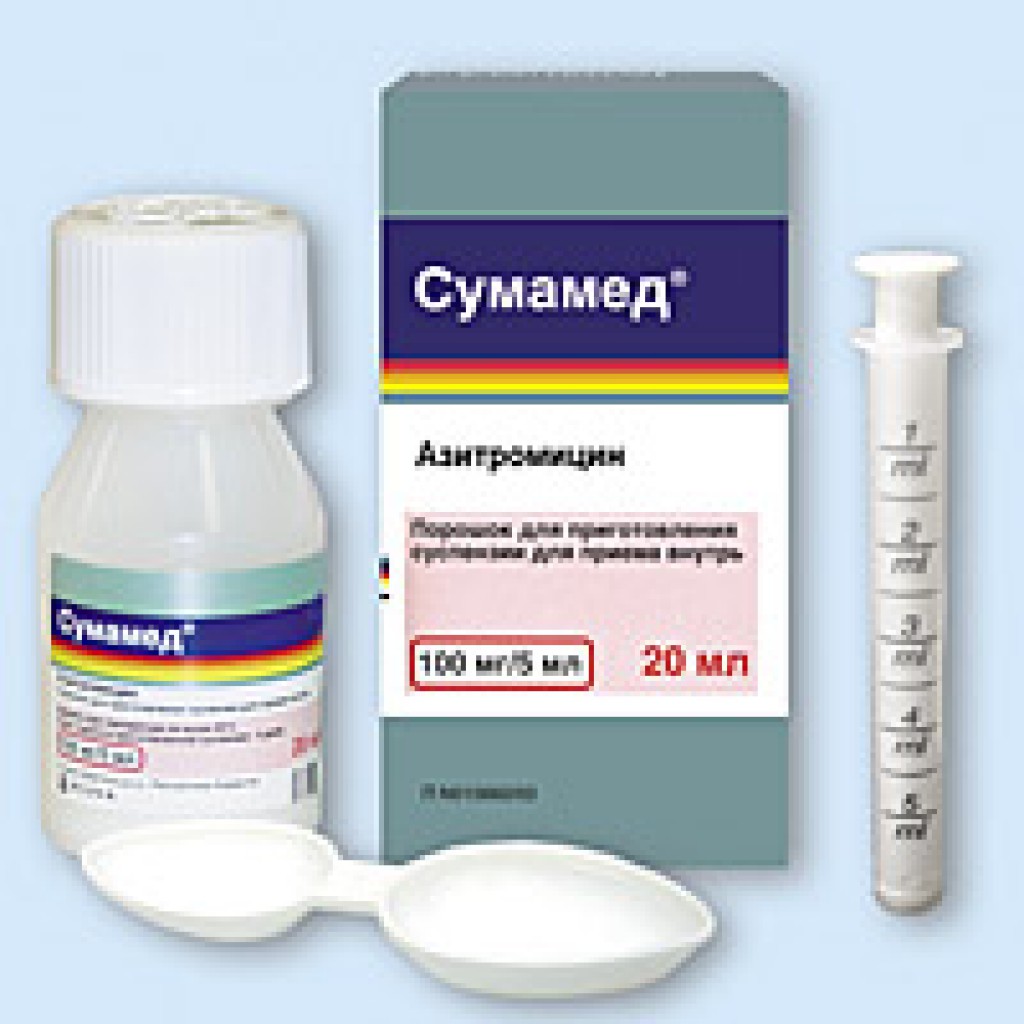 One of similar drugs– Sumamed based on the active substance azithromycin. Its action and features, if necessary, can be studied in more detail in the article “”. Sumamed is effective if the cause of the disease is:
One of similar drugs– Sumamed based on the active substance azithromycin. Its action and features, if necessary, can be studied in more detail in the article “”. Sumamed is effective if the cause of the disease is:
- Pneumococcus;
- Streptococcus pyogenes;
- streptococci C, F, G;
- legionella;
- Staphylococcus epidermidis.
Very convenient and the fact that this medicinal product Available in various forms:
- tablets containing the active substance 125 mg and 250 mg;
- capsules containing 250 mg of active substance;
- lyophilisate for preparing a solution;
- powder for suspension.
Important! It is impossible to say which one existing antibiotics the most effective, since an individual course of therapy is selected for the treatment of each patient.
Amoxiclav (Augmentin)
 Among the frequently prescribed drugs, Amoxiclav (Augmentin) stands out. The two components included in its composition - amoxicillin, which can be read about in our other article "", and clavulanic acid - contribute to high level drug activity. The product effectively relieves respiratory syndrome and other manifestations with minimal side effects.
Among the frequently prescribed drugs, Amoxiclav (Augmentin) stands out. The two components included in its composition - amoxicillin, which can be read about in our other article "", and clavulanic acid - contribute to high level drug activity. The product effectively relieves respiratory syndrome and other manifestations with minimal side effects.
Flemoxin Solutab (Amoxicillin)
 It is impossible not to mention Flemoxin Solutab, the main active substance which is amoxicillin. You will learn more about this drug from the article “”. It has a wide spectrum of action and is included in the list of the safest antibacterial agents for bronchitis. According to doctors, these are the most effective medicines from bronchitis. You can verify this by reading the article.
It is impossible not to mention Flemoxin Solutab, the main active substance which is amoxicillin. You will learn more about this drug from the article “”. It has a wide spectrum of action and is included in the list of the safest antibacterial agents for bronchitis. According to doctors, these are the most effective medicines from bronchitis. You can verify this by reading the article.
Interesting: The advantage of Flemoxin Solutab is its release form - it is a dispersible tablet.
This means that taking so effective remedy for bronchitis you can use any convenient method:
- suck like a lollipop;
- chew;
- dissolve in a small amount cool water and drink;
- dissolve cool in tea or juice.
New generation antibiotics for bronchitis
Scientists are constantly working to improve antibacterial agents. That is why new generation drugs are more effective and have minimal side effects. Characteristic feature There is also an effect on many pathogens, which the first generation of medicines could not allow.
